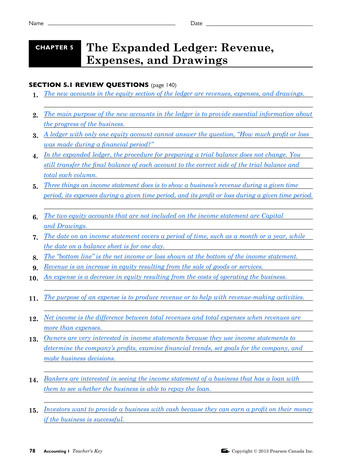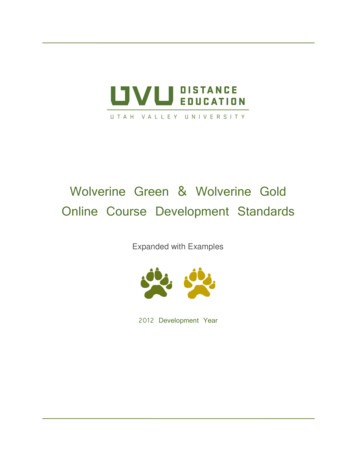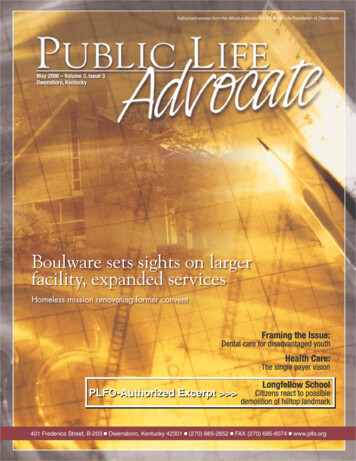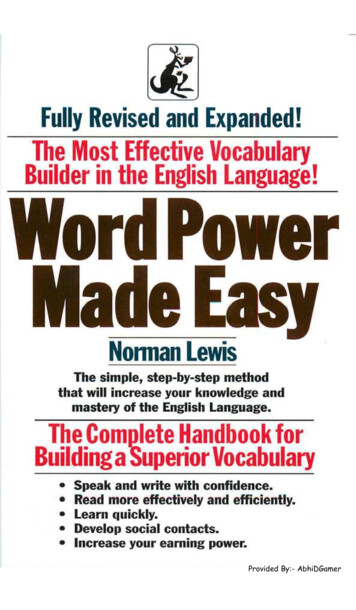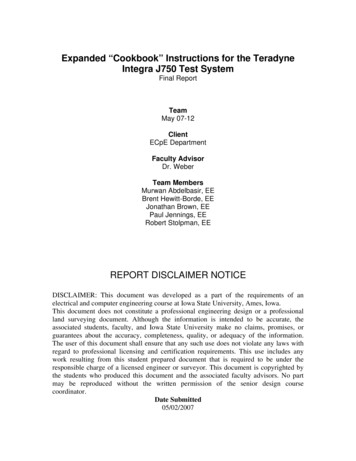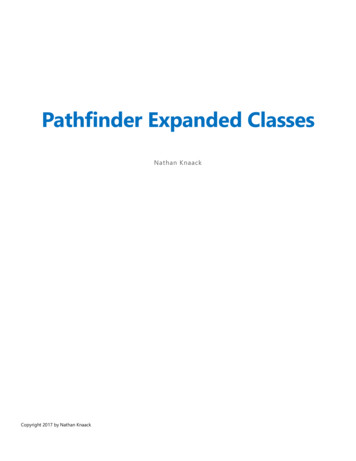
Transcription
Pathfinder Expanded ClassesNathan KnaackCopyright 2017 by Nathan Knaack
Table of ContentsTable of Contents . 2Introduction. 3Chapter 1: Classes . 5Aberrant . 6Brave . 11Champion . 17Courtier . 20Explorer . 24Leader. 29Luchador . 33Priest . 38Shapeshifter . 45Tinker . 50Warlock . 59Chapter 2: Feats . 68Chapter 3: Traits. 74Open Game License . 762
IntroductionThis book was written out of spite.Wait, that’s a terrible way to introduce a book. Let me start over.I love Pathfinder just as much as I loved Dungeons & Dragons before it, a game I’ve enjoyed for over thirtyyears at the time of this writing. When I was in middle school, my mother surprised me with a complete set of1st Edition guidebooks she’d found at a garage sale for fifty cents each. As a typical suburban nerd, I wasquickly enthralled. Indeed, the early discovery of Dungeons & Dragons is what encouraged me to start writingshort stories about my characters and the adventures they had, which in turn led me to pursue a degree inEnglish Literature, which is how I ended up writing professionally.When 2nd Edition was released, I was reluctant at first, but eventually came to adore it. Then came 3rd Editionand I wondered how I’d ever gotten by with any of the other systems. After several attempts at getting into 4thEdition D&D, though, I just didn’t feel the same magic. I was about to resign myself to, for the first time,reverting to an earlier edition of the game instead of fully adopting the latest one. Luckily, a friend of mineintroduced me to Pathfinder and I found what I’d been yearning for all along: a fresh new take on the solidmechanics laid down by 3rd Edition D&D, cleaning up some of the problematic areas and expanding oneverything the system did right.For years, I thoroughly enjoyed the Pathfinder experience, taking part in countless homebrewed adventures,Pathfinder Society Modules, and long-term campaigns. While I was working for CCP Games, we had a groupthat maintained a steady E6 campaign for years, which is an impressive feat for a bunch of busy adults withyoung children, video game industry “crunch time,” and those notorious Atlanta commutes!During that time, it seemed like every Pathfinder release was better than the last. The Golarion campaignsetting was extremely well designed and most of the rules supplements introduced exciting new features,created interesting new playstyles, and generally added to the core game experience without feeling likeneedless “bloat,” the inevitable fate of RPG publishing that’s killed off so many beloved systems over the years.So, when I heard about the Advanced Class Guide, I felt like that teenage kid again, about to open up anotherbook full of exciting new options for my fantasy characters. When I read about it in the Paizo forums, though,my excitement began to fade. Hybrid classes with “cut and pasted” (a quote from one of the designers) abilitiesfrom two parent classes? Why do we need those in a game that already includes a robust multi-classingsystem? Another take on the holy warrior, the warpriest? Don’t we already have clerics, paladins, andinquisitors? And the arcanist, a class that combines the sorcerer and wizard, the two that are already the mostalike of them all? What’s the overall theme of the slayer, “a guy who does lots and lots of damage?” After allthis time and several half-hearted attempts at getting a real charisma-based, Errol Flynn style duelist into thegame, the final, official stab at it is a fighter/gunslinger hybrid with expendable points per day? I was hopingthe developers would actually put some real effort into bringing that iconic role to life. The same goes theskald and shaman; these were interesting concepts that deserved better than hybrid bastardization.I voiced my opinions and even got some direct responses from the developers, but they were already well ontheir way to publishing the Advanced Class Guide. To me, it felt like an aging rock band putting out a greatesthits album. Sure, the diehard fans will shell out for it, but they’d much rather have seen something new,something more interesting and engaging.3
This all went down at about the same time I had written and self-published my first novel, Revenge Insurance.Is that a shameless plug? Maybe, but who are you to judge? You’re still reading something that started with theline “this guide was created out of spite,” so let’s not go pointing fingers, all right? The point is: I had 30 yearsof RPG experience, 10 years of designing games, and now I’d gone through the whole self-publishing process.What was stopping me from creating my own third party material for Pathfinder?So I put my time where my mouth was and sat down to create a supplement with more exciting, relevant, andnecessary classes than I found in the Advanced Class Guide. Some of these concepts have been around for awhile, but never really given a proper, official treatment in Pathfinder. Others might seem familiar, but aredesigned to fill the gaps in the existing selection of core classes. One of them even started out as a joke, butafter some serious research, turned out to be a fun and glorious playstyle option. When you get to that class,ask yourself this question: “Who am I to judge which real world culture’s myths and legends are valid andwhich are inappropriate for a fantasy roleplaying game? How is this class any sillier than a pointy-eared elf whoshoots arrows or a squirmy little gnome who casts magic spells?” Give it a chance and you’ll see what I mean.There are a few other things to keep in mind with these classes, too. Those of you who had an experience likemine with 4th Edition aren’t going to want to hear that I’ve applied some of my learnings from video gamedevelopment into this guide, but trust me on this. Most of these classes have “rotations,” cycles of abilities thatmake them both more effective and engaging. No more standing in one square for an entire battle, waiting foryour turn in the initiative order to come up again so you can roll one d20 for a single attack. Rotations requirethinking ahead, coordinating with teammates, and executing your most powerful abilities at just the rightmoment.Some of you are going to quickly notice something else: I really hate “per day” abilities, so they’ve beenminimized as much as I could possibly manage. Systems have been put in place to make each ability onlyavailable at certain times during battle, but some of you are going to extrapolate that into how often they canbe used out of combat. Some of you are going to try to justify doing obnoxious things with these powers andsome of you are going to have inexperienced, overly accommodating, or outright foolish game masters whoallow that sort of thing. I keep saying “some of you,” but what I really mean is “assholes.” As the imitable MonteCook famously said: “I don’t want to design games for assholes” – and neither do I. Please don’t be an assholewith what you find in this guide.If anyone is still reading this, I think it’s safe to assume you’re not easily offended, so I hope you’ll also forgivethe abrupt conclusion. Without further ado, here it is: an unofficial Pathfinder supplement full of fun newclasses, created out of spite by an overgrown nerd, and designed it for everyone but assholes. Enjoy!Nathan Knaack20174
Chapter 1: ClassesAberrantOrdinary people who learn to harness a mysterious energy welling up within them and unleash it in a variety offorceful effects.BraveFierce warriors who favor fast-moving tactics, guided by ancestral spirits that provide a wide variety ofbeneficial effects.ChampionCourageous and charismatic warriors who lead the charge, valiantly supporting their allies in and out ofcombat.CourtierGraceful duelists and unparalleled diplomats who pride themselves on having wits as quick as their rapiers.ExplorerCurious and slippery adventurers who delve into the deepest dungeons in search of the lost treasures ofancient legend.LeaderInspiring administrators and commanders able to guide their loyal companions and allies to victory witheffective commands and timely assistance.LuchadorMasked grapplers who use a marvelous array of dazzling moves to twist, squeeze, and smash their opponentsinto submission.PriestDivine spellcasters who eschew heavy weapons and armor in favor of earning more power from their deity inthe form of added spells, enhanced channels, and even divine intervention.ShapeshifterVersatile combatants with the ability to change their shape at will, taking on various animal forms andperfecting their instinctual abilities as they gain experience with each.TinkerClever engineers who use invent mechanical wonders, advanced armaments, and sturdy constructs to rival anymagical effect.WarlockLost souls tormented by evil outsiders who lay curses on their enemies even as they endure the constantannoyance of an inescapable underworld companion.5
AberrantSome people are born with an innate power boiling up inside of them. Others discover it later in life, uponmaturation, coming into contact with ancient powers, or in the wake of a traumatic experience. However ithappens, the affected individuals are never the same. They begin to exhibit strange and powerful energies,which they can learn to focus into amazing and deadly effects.Role: Each aberrant’s choice of powers is going to determine their role in combat, while their source is willprovide them with a selection of skills to use everywhere else. There are three main categories of powers: thosethat bolster the aberrant’s focus when held, those that produce instantaneous effects when his focus is spent,and those that create lingering effects when his focus is spent and not immediately gathered.Alignment: AnyHit Die: d8Starting Wealth: 2d6 x 10gp (average 70 gp), plus an outfit worth 10 gp or less.Class SkillsThe aberrant’s skills are Craft (Int), Perception (Wis), and Profession (Wis). He also gains class skills based on hissource (see below).Skill Ranks Per Level: 4 Int modifier.Table: The AberrantLevelBase Attack th15th16th17th18th19th20th 0 1 2 3 3 4 5 6 / 1 6 / 1 7 / 2 8 / 3 9 / 4 9 / 4 10 / 5 11 / 6 / 1 12 / 7 / 2 12 / 7 / 2 13 / 8 / 3 14 / 9 / 4 15 / 10 / 5FortSave 2 3 3 4 4 5 5 6 6 7 7 8 8 9 9 10 10 11 11 12RefSave 2 3 3 4 4 5 5 6 6 7 7 8 8 9 9 10 10 11 11 12WillSave 2 3 3 4 4 5 5 6 6 7 7 8 8 9 9 10 10 11 11 126SpecialFocus, Power, rPower
Weapon and Armor Proficiency: Aberrants are proficient with all simple weapons. They are not proficientwith any armor or shields. Wearing any armor or using a shield interferes with an aberrant’s abilities, preventingthem fro
Pathfinder Society Modules, and long-term campaigns. While I was working for CCP Games, we had a group that maintained a steady E6 campaign for years, which is an impressive feat for a bunch of busy adults with young children, video game industry “crunch time,” and those notorious Atlanta commutes! During that time, it seemed like every Pathfinder release was better than the last. The .



